
| What is Flavor and Fortune? |
| How do I subscribe? |
| How do I get past issues? |
| How do I advertise? |
| How do I contact the editor? |
Read 13102397 times
Connect me to:
| Home |
| Articles |
| Book reviews |
| Letters to the Editor |
| Newmans News and Notes |
| Recipes |
| Restaurant reviews |
| Article Index (all years, slow) |
| List of Article Years |
| Article Index (2026) |
| Article Index (last 2 years) |
| Things others say |
| Related Links |
| Log In... |
| Authors |
| Categories & Topics |
Tea: One Plant but Many Varieties
| by Jacqueline M. Newman |
Beverages
Fall Volume: 2006 Issue: 13(3) page(s): 12, 13, 14, 15, and 35
There is much misinformation about the many kinds of this centuries-old beverage, called cha, chai, te, tea theier, teestrauch, and many more names. All beverages made from leaves of this one plant, Camellia sinensis, are related no matter what they are called, And, they all are stimulants. The plant itself is a woody perennial with thin leaves when young, wider ones as the leaf ages. Aging leaves are somewhat glossy. People find a few twigs included in many of these older leaves because infusions made from them often taste better.
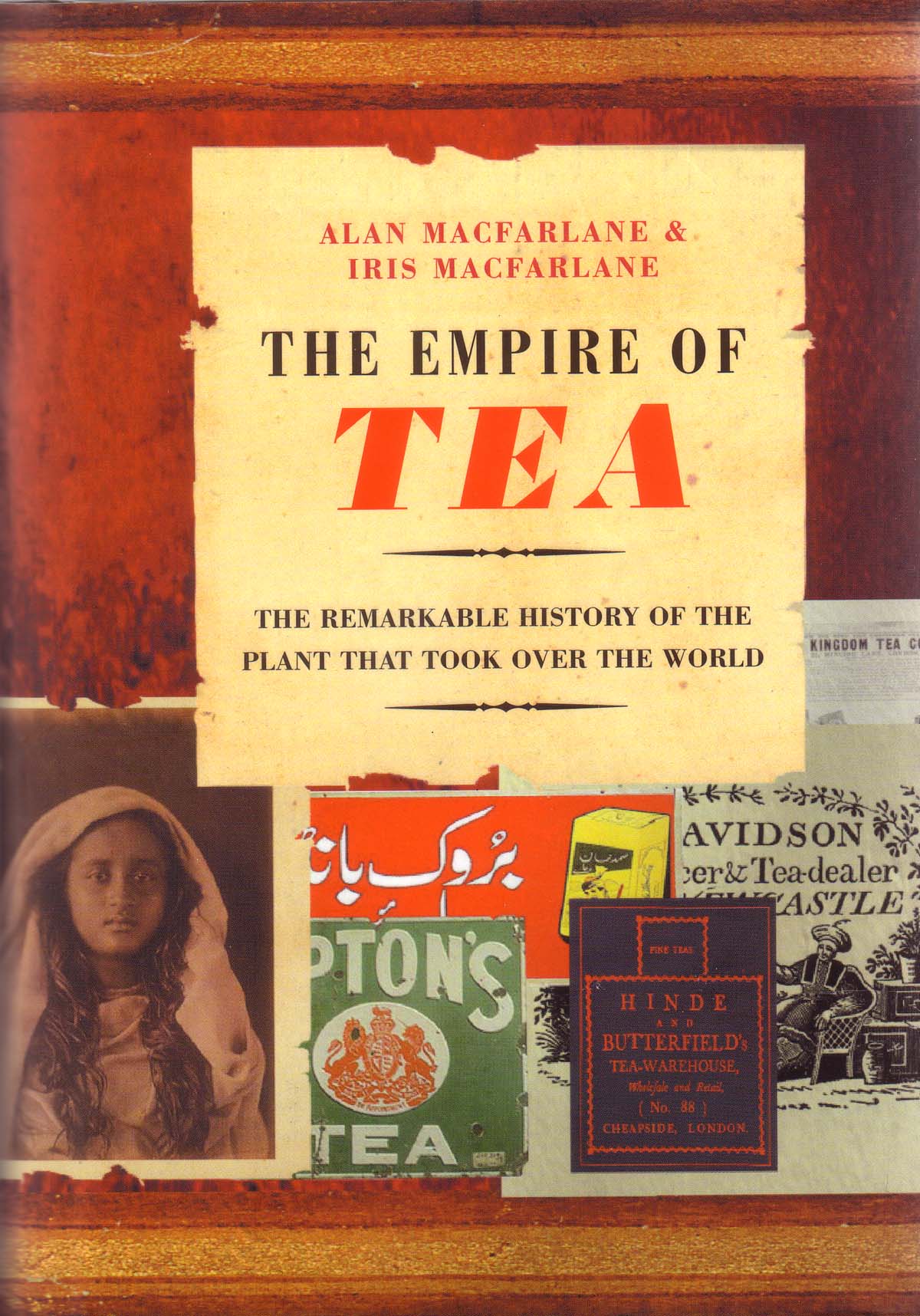 The Chinese, beginning at least in the fourth century BCE, were drinking infusions of tea leaves. Buddhist monks and lay people used tea then and now before meditating. They called in cha or chaye. To aid in picking its leaves, the plant is commonly pruned to shrub-size, but it can grow to tree-height. Many ancient large tea-trees can be found. This magazine detailed early stories and other information about tea in in Volume 6 (1) on pages 5, 6, 22, and 23.
The Chinese, beginning at least in the fourth century BCE, were drinking infusions of tea leaves. Buddhist monks and lay people used tea then and now before meditating. They called in cha or chaye. To aid in picking its leaves, the plant is commonly pruned to shrub-size, but it can grow to tree-height. Many ancient large tea-trees can be found. This magazine detailed early stories and other information about tea in in Volume 6 (1) on pages 5, 6, 22, and 23.
Tea is indigenous to southern China and nearby countries. Its common English name is based upon its name in a southern Chinese dialect and all true teas are from the above named Camellia plant. There are two main varieties and several newer hybrids. In India, the variety is Camellia assamica. It has thinner more pointy leaves than does China's Camellia sinensis. The hybrid varieties can have either leaf shape.
A recent statistic said that two and a half million tons of tea leaves are produced annually, the Chinese the world's largest consumers. Any leaf on any tea plant can be used to make tea, but certainly the best ones use a bud and a few close leaves used for their infusion. Tea-like beverages made from other plants are correctly called infusions but they are not real teas and are properly called 'tisanes.'
In India and in western countries, black tea is so-called as it refers to the color of its processed leaves. This is the most common tea consumed worldwide. In China, Japan, and many other Asian countries, green tea is the one most consumed. While the Chinese do consume black tea, they do so in lesser quantities and they do not call it black tea. To them, it is red tea. Why the color-name difference; because the color of the infusion or liquid is red.
The other tea-colors, such as green tea, are known by their same color-names in most countries. These and all color differences reflect the way the leaves are processed. The Chinese primarily drink green, red, yellow, and white teas. They also consume oolong tea. That, color-wise, is between red and green tea.
To make red/black tea, one needs a several-step process. Most commonly, the leaves are withered, rolled, then heated, sorted by grade, and finally packed. Sounds simple, but it is not. Even words to explain preparing tea leaves can cause confusion. Different ones are used by different people. For example, the Chinese are more apt to call the first step after picking, panning. They put leaves in bamboo trays and allow them to dry for a short length of time. Others use the term panning to mean cooking or even heat-dry-frying tea leaves. After the above-named step or steps, tea leaves can be steamed, pan-cooked, or dry-fried.
Green tea gets a little drying then steaming or a little heating in a wok, then more drying or rolling and still more time to dry. All steaming is for a controlled period of time. The next process when making black tea is to bruise the leaves, most often by shaking them. This process is correctly called oxidation. Tea leaves are then dry-fried, then cooled, sized, graded, and packed. The polyphenols in the leaves and their catechins are made bio-available during this step. Some use the word fermentation for this part of the process, however as nothing gets fermented, it is a misnomer.
Some say the leaves are fired in this process, This is another mis-naming because they are dry-fried, a pan between them and any fire. When this process of oxidation is stopped earlier than when making black tea, the tea is called oolong. Differences in length of oxidation is why teas vary in color, flavor, taste, and chemical composition. When oxidized a mite more than most green teas, a further refinement in naming of tea occurs. At this point, it is called oolong tea. If done a mite more, the correct name is 'Formosa oolong.' Those in Taiwan (formerly called Formosa) like their oolong tea a bit closer in taste to black tea then green tea; hence that name.
Other tea-colors not yet discussed are yellow and white. Teas oxidized for less time than are green teas are called yellow teas. Tea leaves with hairy-down on their upper surface and less oxidized than yellow teas, are called white teas. White tea is in short supply and considered special. White and yellow teas are exceptionally mild in taste, light in color, and often more expensive.
All tea leaves should be infused with very warm or hot water, different temperatures for different kinds of tea. In China, tea is consumed without adding sugar, lemon or cream, except in Mongolia and Tibet. There, substantial amounts of milk, butter, and/or sugar can be and is added to their hot black tea.
There is yet another processing of tea leaves. It is to make 'pu-er' tea. This tea is made with large tea leaves and they are oxidized twice. Good pu-er teas are additionally aged. They are the only teas consumed in China that are more than a year old; it is intentionally aged. Economically, pu-er teas can be compared to better wines. The older ones are more expensive and considered better. The Chinese consider aged pu-er the best of all teas. Inexpensive supermarket varieties are available, but are usually two to five years old; their taste is not considered impressive.
In restaurants, a twenty-five year old pu-er tea can cost fifty to one hundred dollars for one pot; extra water for second and later infusions are free. In Las Vegas one resort charges fourteen dollars a serving and that is not for a pot. One Chicago hotel has different ages of pu-er available, the oldest costing more than two hundred dollars a pot.
This magazine wrote about pu-er tea in Volume 10, Number 1, on pages 23 and 24. Other tea articles can be located in the 1994-2003 and more recent index listings. These are on the magazine’s website at www.flavorandfortune.com Aged pu-er teas are often served at banquets. This editor wrote about one had in a Toronto eatery called the Lai Wah Heen restaurant. They served a twenty-five year pot with unlimited refils for one hundred dollars.
Pu-er teas are primarily grown in the Yunnan province. Read more about them in articles discussing foods and beverages there. Not only is pu-er made with large leaves, some small amount of stems are purposefully included. Many pu-er teas are shaped by compression and called tuocha tea. Though double oxidized, this variety of tea is not always black; it can be green or oolong. It is always considered refreshing and cooling.
Should you be in the Yunnan province and invited to a Hundred Flowers Banquet, jump at the opportunity. There are tribal pu-er teas there flavored with magnolia blossoms. They are served at this type of banquet along with great food.
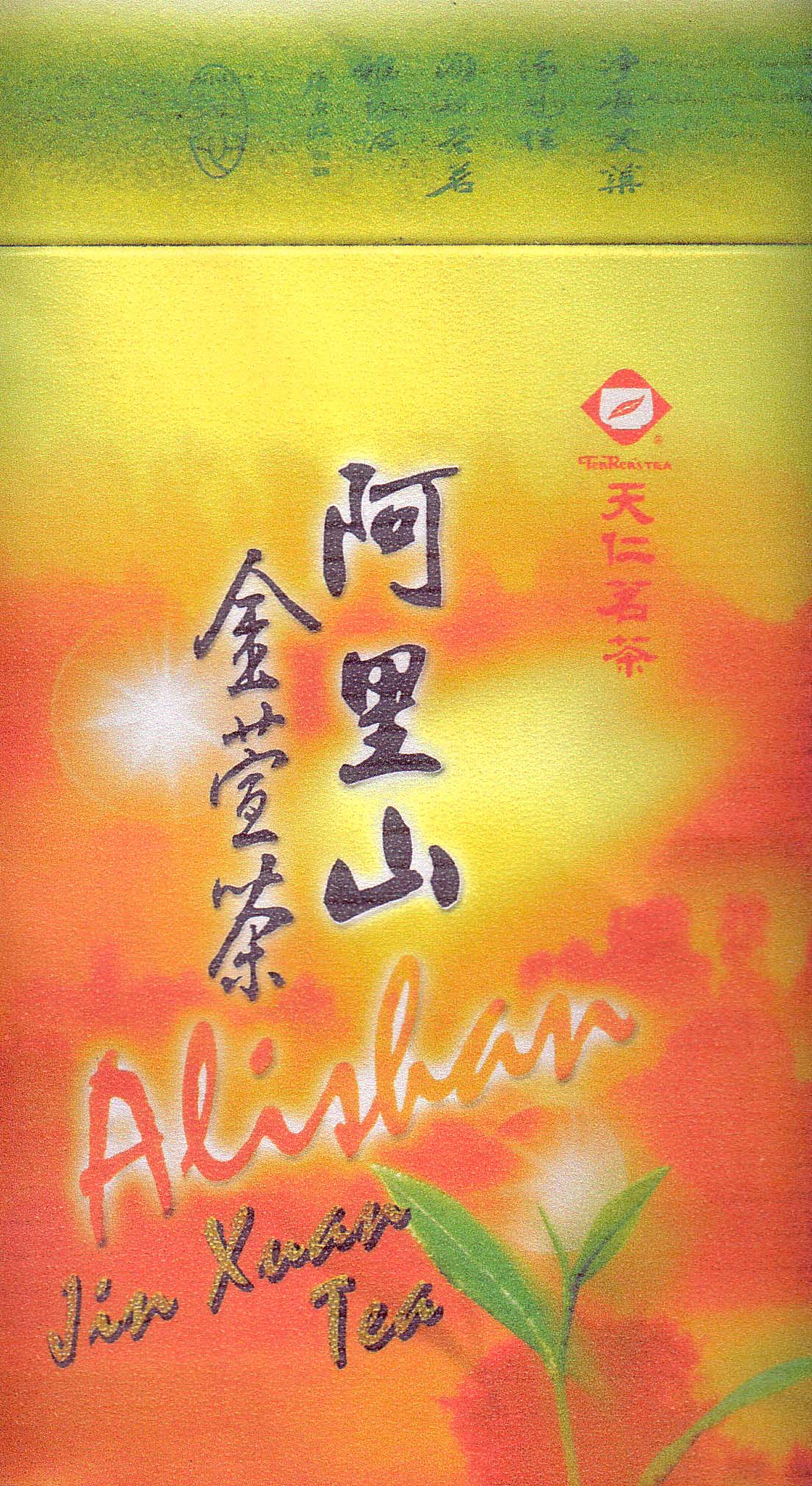
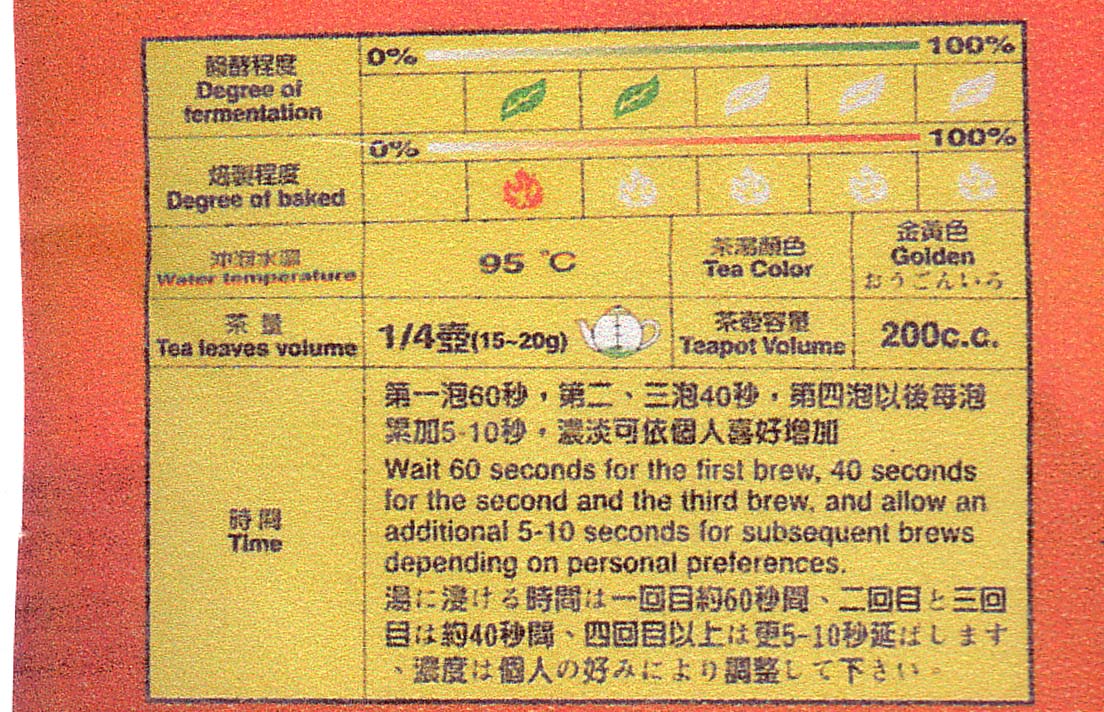 Like wine, tea is known by the region it comes from. Teas from China’s famous mountainsides and famous lakes are considered the best. In addition to processing and location of origin, tea leaves can be and often are flavored with lemon, bergamot, jasmine, rose, litchi, and other flowers or essences. Some are made by adding spices such as cinnamon and mint. Making a tea infusion with or without added items requires very warm to hot water, depending upon tea-leaf color. It can be served hot or tepid. Iced tea is western notion, not a Chinese one.
Like wine, tea is known by the region it comes from. Teas from China’s famous mountainsides and famous lakes are considered the best. In addition to processing and location of origin, tea leaves can be and often are flavored with lemon, bergamot, jasmine, rose, litchi, and other flowers or essences. Some are made by adding spices such as cinnamon and mint. Making a tea infusion with or without added items requires very warm to hot water, depending upon tea-leaf color. It can be served hot or tepid. Iced tea is western notion, not a Chinese one.
From a health perspective, tea has garnered lots of press recently. This beverage has many bio-active micro-constituents such as phenolic compounds terpenoids, isoflavones, glucosinolates, flavanoids, plant sterols, sapanins, and other phytochemicals. It is a stimulant because it has caffeine and other components such as theobromine. Some research touts the anti-carcinogenic effects of tea. However, tests on animals other than homo sapiens are inconclusive. Tea is touted as an aid for those with Alzheimer’s disease. That, too, has not been demonstrated conclusively.
Most research touts green tea for its health effects. That may be why green tea imports rose from three percent to twelve percent in the last ten or so years. The Food and Drug Administration in the United States says there is no credible evidence yet, except for some breast or prostate cancer types. They also say that even the evidence they have can not be deemed conclusive.
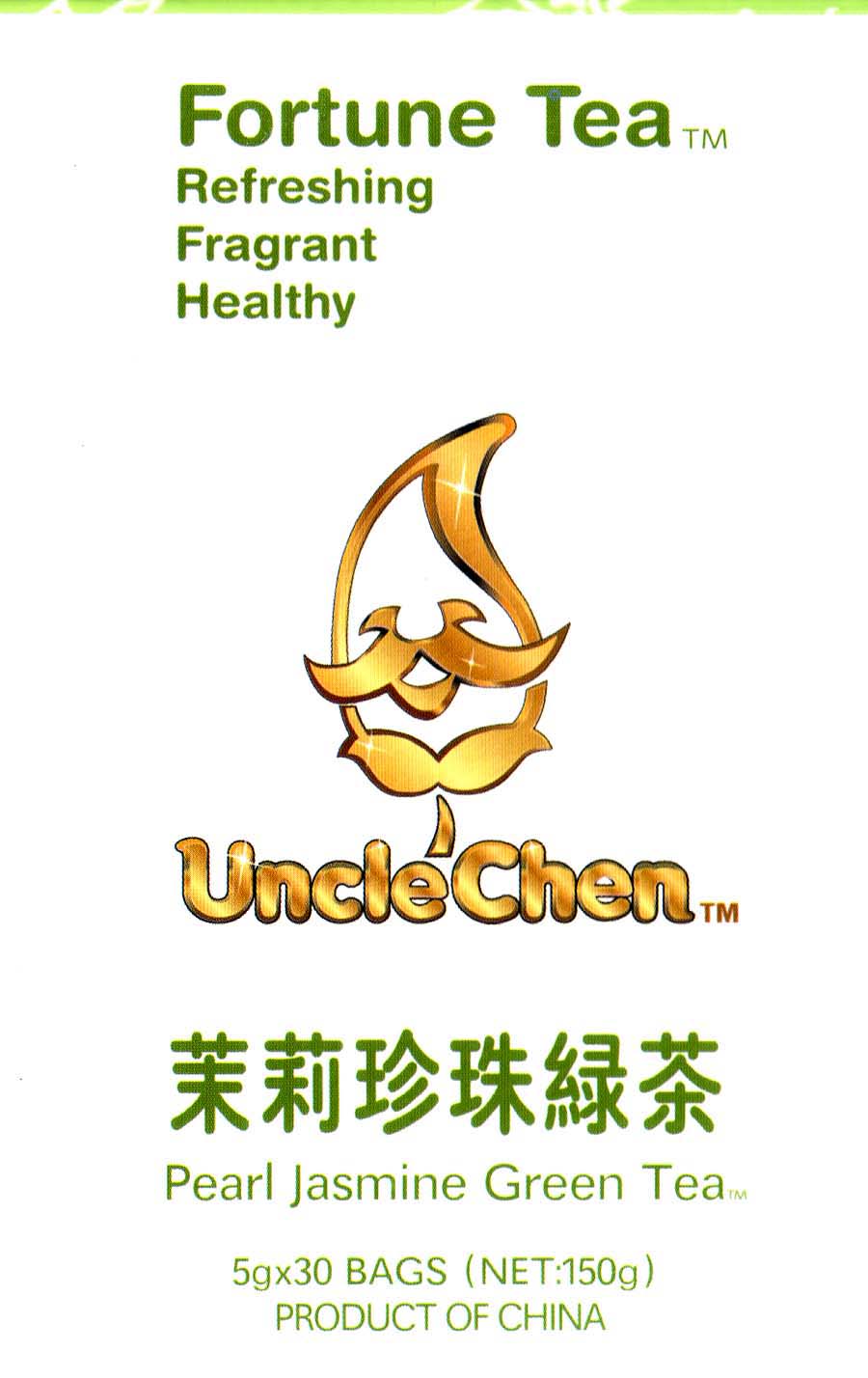 Tea, besides its super taste, rewards and punishes those who consume it by aiding wakefulness, increasing calorie and metabolism with added sugar and cream, and having little to no effect on body weight even when it acts as a diuretic.
Tea, besides its super taste, rewards and punishes those who consume it by aiding wakefulness, increasing calorie and metabolism with added sugar and cream, and having little to no effect on body weight even when it acts as a diuretic.
China produces many kinds of tea, perhaps thousands of different kinds with many different names. For example, black teas can be called China Congou; some of them are seasonal. This past year, Ten Ren Tea and Ginseng Company sold a winter tea from the Ali Mountain area; they called it Alishan. It was a Jin Xuan tea that is very aromatic and quite terrific. Like many winter teas, it had a high mineral content. Tea afficianados prefer their teas green and picked in spring and summer, their longer processed ones picked more in winter.
Experts advise that tea leaves are best within the first three months after processing, but that they can be kept in a dry dark container such as a can, one with a tight lid. Kept that way, tea can stay for up to two years. We prefer to purchase small amounts and refresh the supply more often than that. Actually, we prefer ours kept less than half a year, be that in their place or ours.
We serve tea in good teapots, the smaller the better. Those made of purple clay that dries orange-brown are considered best. The Chinese tout three main teapot styles: Pure, Slower, and Imitation. What these actually are, have almost as many definitions as there are varieties of tea.
When brewing tea put lots of leaves in a small pot but not too many so they do have no room to expand. After putting tea leaves in, pour boiling water over them and discard this water immediately; it rinses the leaves, allows them to begin expanding, and helps them fully develop. The next batch of hot water is the first tea-liquid consumed after brewing. It will be sweeter, less bitter, and better tasting than that initially discarded liquid. The next water poured and brewed is thought to be the best brew. Some teas such as pu-er, can be very good after thirty or more brews. Tea with stems and leaves flavor the brew and round out the taste more than do leaves alone.
Tea masters like to make their own teapots. The sand they use rinses their hands when making them and it adds extra flavor to teas made in their teapots. Their proteges tend to agree.
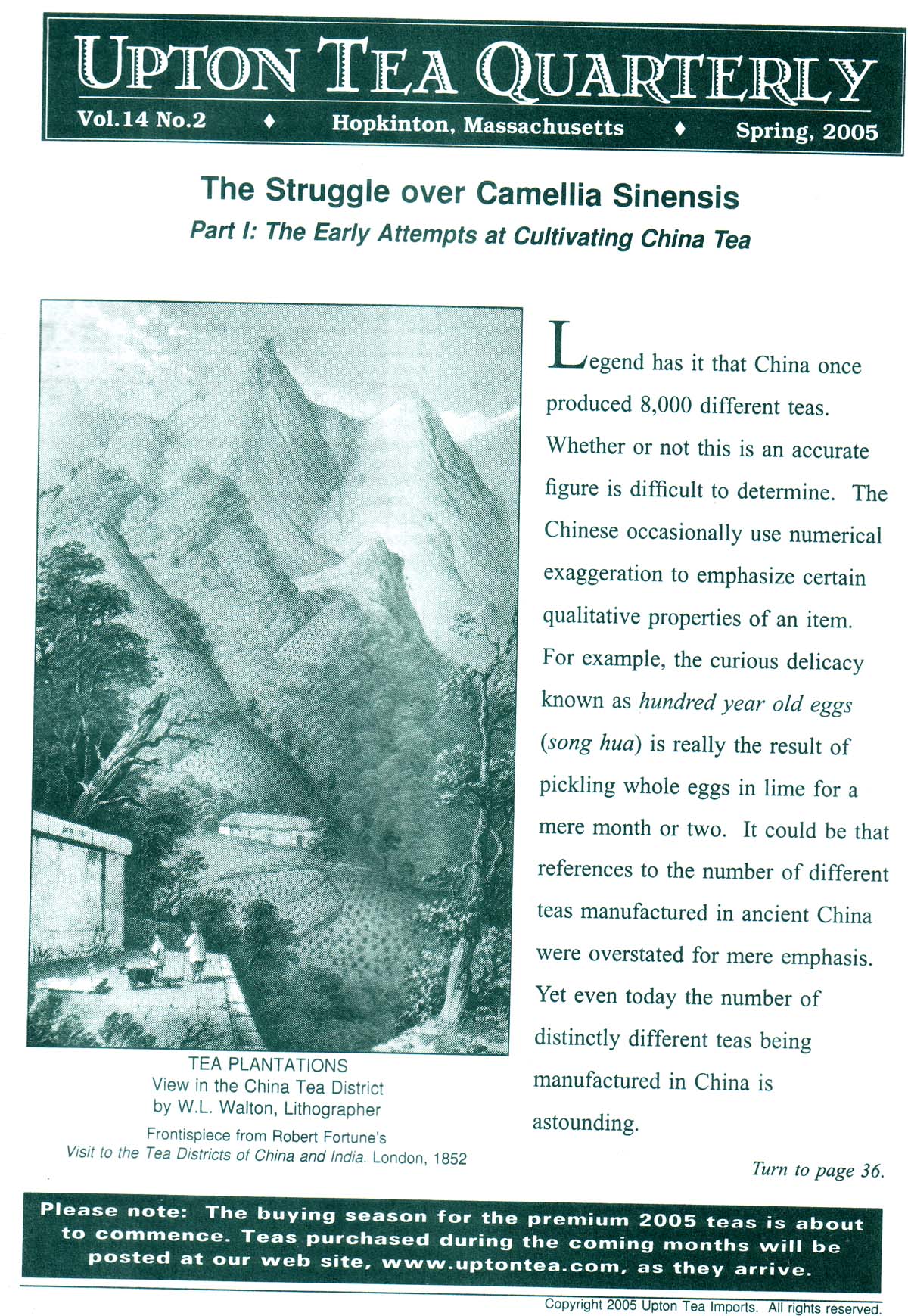 To learn more about tea and appreciate it more, taste more teas, and do so often. Most tea emporia do not sell less than two ounces; and that is the most one should buy at any one time. One seller has a phenomenal catalogue; they sell sample packets for a dollar or two; it is the Upton Tea Company; 34-A Haydon Row Street; Hopkinton MA 01748; phone: 800) 234-8327. Their multi-country tea catalogue is an education in itself. The cover of one quarterly issue is pictured with this article. Tasting tea can be a valuable education; and you can taste many from their a catalogue for not too much money when purchasing their sample size.
To learn more about tea and appreciate it more, taste more teas, and do so often. Most tea emporia do not sell less than two ounces; and that is the most one should buy at any one time. One seller has a phenomenal catalogue; they sell sample packets for a dollar or two; it is the Upton Tea Company; 34-A Haydon Row Street; Hopkinton MA 01748; phone: 800) 234-8327. Their multi-country tea catalogue is an education in itself. The cover of one quarterly issue is pictured with this article. Tasting tea can be a valuable education; and you can taste many from their a catalogue for not too much money when purchasing their sample size.
If visiting San Francisco, enjoy consuming and buying teas at the Imperial Tea Court; 1411 Powell Street; San Francisco CA; phone: (415) 788-6080. Theirs is an actual tea house moved piece by piece from China to that city. When coming to New York City, taste and try their teas at Ten Ren Tea and Ginseng Company; 75 Mott Street; New York City; phone: (212) 349-2286. They have other stores in Flushing and Brooklyn and many other locations in the United States, call for exact locations and direction to (800) 292-2096. The Tea Gallery; 131 Allen Street; New York City NY; phone: 212/777-6148 is a five minute uptown trek from Chinatown; they have fine teas, too, and you can get hours from them and all these tea locations.
There are many other fine tea vendors, look for them using Google, Alta Vista and other search engines. There are hundreds of places that sell good tea leaves. These are always better than tea bags, no matter how made and with whatever contents their manufacturers tout. Most places have websites and professionals who, by phone, can advise about their products and prices. Do not let large dollar amounts put you off. Keep in mind that a pound of coffee makes forty cups while a pound of tea makes two hundred cups.
How companies package their whole tea leaves matters as does quality and freshness. Union International Food Co.; 33035 Transit Avenue; Union City CA 94587 sells their jasmine tea balls in five gram vacuum-sealed small bags, thirty to a box, That is the only tea we keep in purse or our luggage; it enables fine fresh tea whenever desired.
Tea can be and is more than a beverage. In the United States it is a billions of dollars a year business. And it is more than that. It is a medicinal first used in China as a decoction alone or with other ingredients. Herbal stores and tea emporia sell many types of what the Chinese believe are health-promoting teas. These are tea leaves mixed with other items. Check with Fang Leaves and Petals on their website; they have an information sheet that touts different flavorings for use in tea by themselves, or for a plethora of reasons. Also check the bottom of their information page; it needs everyone's attention as it says: "These statements have not been evaluated by the FDA. These products are not intended to diagnose, treat, cure or prevent any disease." Heed that advice!
Besides drinking tea, leaves can be used when cooking. This magazine wrote an article in Volume 6(1) on page 25 about cooking with tea; it is available on our website. As in cooking with wine, use the best tea leaves to get the best results. Be aware that different black, green, or oolong teas used in smoking foods changes the flavor of the final product. Foods prepared with tea leaves garner many reader requests. Two are provided below.
Enjoy them and many hours of tea consumption. Drinking tea with others is a true gift of friendship; we raise our cps to your enjoyment of tea and tea-infused foods.
| Tea-smoked Duck |
|---|
1 five- to six-pound fresh Long Island duck 1 teaspoon each of salt and ground white pepper 1/2 cup maltose 1/2 cup Chinese black or Fujianese red rice vinegar 2 Tablespoons dark soy sauce 1 Tablespoon five-spice powder 1/2 cup vegetable oil mixed with one tablespoon sesame oil 1 cup brown sugar 1 cup Lung Ching or Lapsung Souchung tea leaves 1 cup raw white glutinous or regular white rice Preparation: 1. Bring ten-quart pot half-filled with cold water to the boil. Using a heavy fork or a mesh bag, immerse the duck head first, then legs first into the water, two minutes for each end of the bird. Then let the duck air dry for twenty minutes on each side, or hang it for twenty minutes until the skin drys and gets somewhat taut. If it is winter, hang the duck overnight in a garage or similar place, or sit it covered on a rack in the refrigerator. Next sprinkle salt and pepper inside the cavity and on the skin of the bird. 2. In a small pot, bring the maltose, rice vinegar, soy sauce and spice powder to just below the boil, and set this mixture in the pan where the duck will be smoked. 3. Brush the duck with some of the oil now and every twenty minutes. 4. Prepare a charcoal grill or a Weber or similar grill outside the house or in an open garage, cars removed and parked elsewhere. Or use a commercial smoker (and follow the manufacturers instructions). If using a charcoal grill, put a disposable aluminum pan on top of the briquets, or pushing some aside, place it in the center of where they were. If using a commercial grill, put the pan under the grill elements. Fill this pan with the maltose mixture and the rice. When the coals are hot or the grill registers 300 degrees F, set the duck near but not directly over the coals or the elements. Make a loosely put together aluminum foil tent to partially enclose the smoke. 5. Smoke the duck for three to four hours, or until a meat thermometer indicates the poultry is cooked. Do not leave the thermometer in the duck, insert it after two hours to check for doneness. 6. Remove the duck from the smoker, let rest half an hour, then chop into two-inch pieces, and serve. |
| Marble Eggs |
|---|
10 fresh eggs 2 Tablespoons black or a mixture of black, oolong, and green tea leaves 4 whole star anise 1 teaspoon coarse salt 1 Tablespoon dark or mushroom soy sauce 1 scallion, tied in a knot 1 Tablespoon fresh ginger, cut into three pieces 1 stick cinnamon 10 pieces dark sugar chunks or one-quarter cup dark brown sugar Preparation: 1. Put pin hole in large end of each egg. Then put eggs in cold water and bring to just below the boil. Simmer them for twelve minutes, then remove from the water, and allow them to cool for half an hour. Discard the water from the pot. 2 Roll the eggs just enough to crack the shell, then return them to the empty pot. Add all of the remaining ingredients and two cups of boiling water. Bring to the boil, reduce the heat, and simmer the eggs for ten minutes. Remove the eggs, and reserve the liquid. But discard any solids. Again allow the eggs to cool, but only until they can be handled and the shells removed. 3. Return the eggs to the liquid, and simmer on low heat for half an hour, then remove and serve the eggs whole or cut in half. Note: They can be served hot, warm, or cool. |

Copyright © 1994-2026 by ISACC, all rights reserved
Address
3 Jefferson Ferry Drive
S. Setauket NY 11720